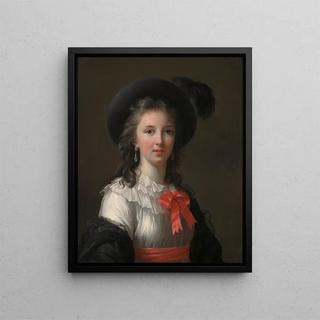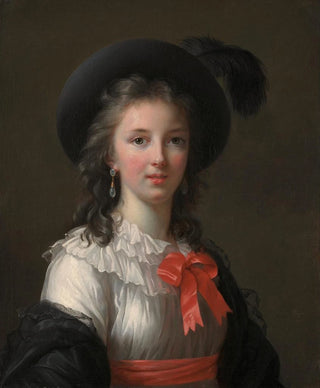Art print Self-portrait - Élisabeth Louise Vigée Le Brun | Art print


View from behind

Frame (optional)
Autoportrait Art print - Élisabeth Louise Vigée Le Brun – Engaging Introduction
In the fascinating world of art history, certain works transcend time and space, capturing the essence of an era while revealing the depth of the human soul. The Autoportrait by Élisabeth Louise Vigée Le Brun is a striking example. This iconic piece, created by one of the first women painters to make a name for herself in the 18th-century artistic scene, is much more than a simple reflection of her image. It is a bold statement on identity, creativity, and the role of women in a male-dominated universe. By painting herself, Vigée Le Brun does not merely claim her talent; she opens a door to a world where women artists can assert themselves and be recognized.
Style and uniqueness of the work
The Autoportrait stands out for its harmonious composition and masterful use of color and light. The artist, with unparalleled skill, manages to create an atmosphere that is both intimate and solemn. The choice of richly detailed clothing and Vigée Le Brun's graceful pose demonstrate her ability to combine elegance and strength. The softness of her facial features, illuminated by subtle lighting, evokes a vulnerability that contrasts with the palpable determination in her gaze. Every brushstroke seems charged with meaning, revealing not only her talent but also her boldness in positioning herself as a woman artist in a still largely patriarchal world. This painting is a celebration of femininity, an ode to beauty and creativity expressed with such fluidity that it captivates the viewer, transporting them into the rich and vibrant universe of 18th-century art.
The artist and her influence
Élisabeth Louise Vigée Le Brun, born in 1755, is an iconic figure of French art. Her career, marked by success and recognition, testifies to her exceptional talent and her determination to establish herself in an artistic environment often hostile to women. She was the official portraitist of Marie-Antoinette, which conferred upon her unprecedented fame. However, her influence extends beyond her era. Vigée Le

Matte finish

View from behind

Frame (optional)
Autoportrait Art print - Élisabeth Louise Vigée Le Brun – Engaging Introduction
In the fascinating world of art history, certain works transcend time and space, capturing the essence of an era while revealing the depth of the human soul. The Autoportrait by Élisabeth Louise Vigée Le Brun is a striking example. This iconic piece, created by one of the first women painters to make a name for herself in the 18th-century artistic scene, is much more than a simple reflection of her image. It is a bold statement on identity, creativity, and the role of women in a male-dominated universe. By painting herself, Vigée Le Brun does not merely claim her talent; she opens a door to a world where women artists can assert themselves and be recognized.
Style and uniqueness of the work
The Autoportrait stands out for its harmonious composition and masterful use of color and light. The artist, with unparalleled skill, manages to create an atmosphere that is both intimate and solemn. The choice of richly detailed clothing and Vigée Le Brun's graceful pose demonstrate her ability to combine elegance and strength. The softness of her facial features, illuminated by subtle lighting, evokes a vulnerability that contrasts with the palpable determination in her gaze. Every brushstroke seems charged with meaning, revealing not only her talent but also her boldness in positioning herself as a woman artist in a still largely patriarchal world. This painting is a celebration of femininity, an ode to beauty and creativity expressed with such fluidity that it captivates the viewer, transporting them into the rich and vibrant universe of 18th-century art.
The artist and her influence
Élisabeth Louise Vigée Le Brun, born in 1755, is an iconic figure of French art. Her career, marked by success and recognition, testifies to her exceptional talent and her determination to establish herself in an artistic environment often hostile to women. She was the official portraitist of Marie-Antoinette, which conferred upon her unprecedented fame. However, her influence extends beyond her era. Vigée Le
12,34 €






